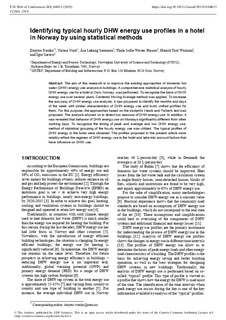| dc.contributor.author | Ivanko, Dmytro | |
| dc.contributor.author | Nord, Natasa | |
| dc.contributor.author | Sørensen, Åse Lekang | |
| dc.contributor.author | Plesser, Thale Sofie Wester | |
| dc.contributor.author | Walnum, Harald Taxt | |
| dc.contributor.author | Sartori, Igor | |
| dc.date.accessioned | 2019-09-24T11:48:44Z | |
| dc.date.available | 2019-09-24T11:48:44Z | |
| dc.date.created | 2019-08-23T16:40:38Z | |
| dc.date.issued | 2019 | |
| dc.identifier.citation | E3S Web of Conferences. 2019, 111 1-8. | nb_NO |
| dc.identifier.issn | 2267-1242 | |
| dc.identifier.uri | http://hdl.handle.net/11250/2618499 | |
| dc.description.abstract | The aim of this research is to improve the existing approaches of domestic hot water (DHW) energy use analysis in buildings. A comprehensive statistical analysis of hourly DHW energy use for a hotel in Oslo, Norway, was performed. To recognize the trend of DHW energy use over several years, Centered Moving Average method was applied. To increase the accuracy of DHW energy use analysis, it was proposed to identify the months and days of the week with similar characteristics of DHW energy use and build unified profiles for them. For this purpose, the approaches based on the student’s t-tests and Fisher’s test was proposed. The analysis allowed us to detect two seasons of DHW energy use. In addition, it was revealed that behavior of DHW energy use on Mondays significantly different from other working days. To recognize the timing of peak and average and low DHW energy use, method of statistical grouping of the hourly energy use was utilized. The typical profiles of DHW energy in the hotel were obtained. The profiles proposed in the present article more reliably reflect the regimes of DHW energy use in the hotel and take into account factors that have influence on DHW use. | nb_NO |
| dc.language.iso | eng | nb_NO |
| dc.publisher | EDP Sciences | nb_NO |
| dc.relation.uri | https://www.e3s-conferences.org/articles/e3sconf/pdf/2019/37/e3sconf_clima2019_04015.pdf | |
| dc.rights | Navngivelse 4.0 Internasjonal | * |
| dc.rights.uri | http://creativecommons.org/licenses/by/4.0/deed.no | * |
| dc.title | Identifying typical hourly DHW energy use profiles in a hotel in Norway by using statistical methods | nb_NO |
| dc.type | Journal article | nb_NO |
| dc.type | Peer reviewed | nb_NO |
| dc.description.version | publishedVersion | nb_NO |
| dc.source.pagenumber | 1-8 | nb_NO |
| dc.source.volume | 111 | nb_NO |
| dc.source.journal | E3S Web of Conferences | nb_NO |
| dc.identifier.doi | 10.1051/e3sconf/201911104015 | |
| dc.identifier.cristin | 1718395 | |
| dc.relation.project | Norges forskningsråd: 902308 | nb_NO |
| dc.description.localcode | © The Authors, published by EDP Sciences, 2019 Licence Creative Commons This is an Open Access article distributed under the terms of the Creative Commons Attribution License 4.0, | nb_NO |
| cristin.unitcode | 194,64,25,0 | |
| cristin.unitname | Institutt for energi- og prosessteknikk | |
| cristin.ispublished | true | |
| cristin.fulltext | original | |
| cristin.qualitycode | 1 | |

